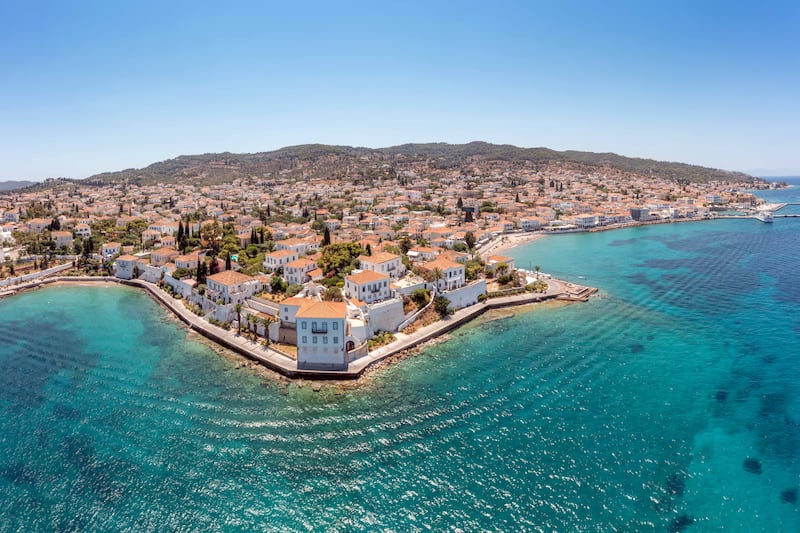Parked on a tiny strip of tarmac, surrounded by the bright blue waters of the Mediterranean and the tufts of green pine trees, sits a gleaming black helicopter with a red racing stripe along its fuselage.
It’s not a particularly common sight on Spetses, one of Greece’s Saronic Islands that’s known for its untouched nature, beautiful beaches and rich maritime history, and the vehicles’ presence has drawn interest from a few passers-by who have gathered around the clearing.
My arrival at the same spot on a chugging orange and cream-coloured tuk-tuk – custom-made for the island’s boho-chic Yayaki guesthouse – adds another unusual element to this summertime scene.

Climbing out of the tuk-tuk, I’m greeted by pilot Giorgio, who tells me he has been flying helicopters for decades. Formerly a search and rescue pilot, the Greek airman now flies charter services around his home country, and is adamant that it's one of the greatest ways for tourists to see the best of the islands.
With more than 6,000 isles, Greece offers travellers an island for every occasion – from the sunset views on crowd-filled Santorini to the culture-laden Syros and the unassuming beaches of Kasos. For travellers on a short trip, the Saronic Islands are the closest archipelago to the Greek mainland and offer seven isles, each with its own eclectic offering.
Having arrived on the 22 square kilometre isle of Spetses a few days ago, I'm gearing up to travel from the island by helicopter, soaring across the Mediterranean Sea to the mainland. It’s a trip that will take about 30 minutes, says Giorgio – quite a timesaver compared to the two hours it would take to travel by road or water. And that's one of the reasons why more travellers are opting to take in the Greek islands via helicopter.
Icarus Jet is the helicopter rental company that I'm flying with, and it provides charters to Greece's top tourist destinations. Some of the company's most popular requests are for aerial trips to Santorini, Mykonos and Naxos. Several other chopper charter companies also exist to fly travellers around the isles, including HeliStar, Helifly and Bellavia, and all of them offer unique routes for island hopping.
In comparison to taking a boat from Athens to Santorini, which would take about four hours, a chartered helicopter can get travellers to the island in just over an hour. Plus, this form of travel brings with it remarkable panoramic views, courtesy of the large cockpit windows and additional windows in the rear.

And since time is saved by cutting down on travel times, passengers can ask pilots to take small detours, allowing them to see even more of the pretty coastal landscapes. It's also a decidedly comfortable way to travel, with air conditioning, plenty of space and, on our journey, even a cooler bag filled with juice and Greek biscuits.
Several of the country’s luxury resorts also have their own helipad landing spots – including Amanzoe in Porto Heli, the same place where Hollywood blockbuster Glass Onion: A Knives Out Mystery was recently shot. In fact, some 40 to 50 per cent of guests arriving at the five-star abode come by helicopter, a representative from Aman Hotels told me.
But for all its perks, helicopter island hopping in Greece isn’t without its problems. For example, private travel always adds more carbon emissions than public transport options, so travellers chartering a chopper should also be committed to offsetting their environmental footprint. Helicopters may account for less than 1 per cent of the aviation industry's CO2 emissions, according to Airbus, but travellers using one for private island hopping will create a much bigger carbon footprint than those taking a public ferry.
There are also limits on when helicopter charters can fly – with Greek authorities only allowing flights from sunrise to sunset for safety reasons. Some weather conditions also impact journeys as helicopters are more susceptible than aeroplanes to bad weather.

And as more travellers opt to island hop via helicopter across Greece, new problems are arising, with competition for parking permits at heliports – especially in some of the most famous islands such as Mykonos and Santorini – becoming extremely fierce, and subsequently limiting time slots for travel.
There's also the issue of weight restrictions. Before I flew, I had to send a record of the weight of both my body and luggage to Icarus Jet to make sure the capacity fits within the strict limitations. This is something some travellers might find a bit invasive, and that also kept me conscious of not eating too many spinach pies and baklava before my flight.
In spite of these niggles, as I soar over the bright blue sea peppered by pine-covered islands and untouched shorelines, it's hard not to see the appeal of helicopter island hopping. No other way of getting around the Greek isles comes with such an unobstructed view of the archipelago.







